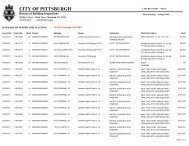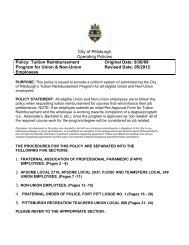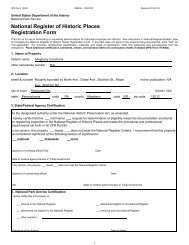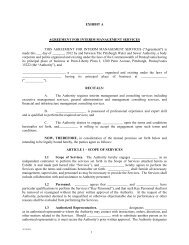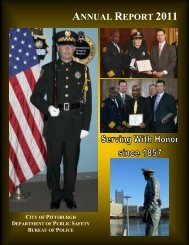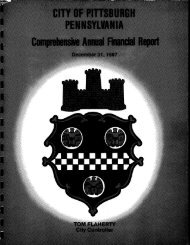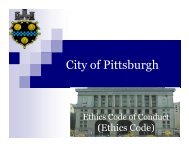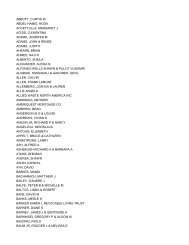east liberty station: realizing the potential - City of Pittsburgh
east liberty station: realizing the potential - City of Pittsburgh
east liberty station: realizing the potential - City of Pittsburgh
Create successful ePaper yourself
Turn your PDF publications into a flip-book with our unique Google optimized e-Paper software.
38<br />
6. Manage parking effectively.<br />
The parking in <strong>the</strong> <strong>station</strong> area and <strong>the</strong><br />
greater East Liberty business district is a<br />
poorly managed mix <strong>of</strong> public and private<br />
surface lots, limited structure parking<br />
associated with newer developments<br />
and on-street spaces, some <strong>of</strong> which are<br />
regulated by residential permit areas.<br />
Currently <strong>the</strong>re is no dedicated parking for<br />
<strong>the</strong> <strong>station</strong>, although a section <strong>of</strong> <strong>the</strong> Shady<br />
Hill Plaza is signed to allow for <strong>station</strong><br />
parking in what appears to be an effort<br />
to manage a tendency for unintended use<br />
<strong>of</strong> an over-sized parking field next to <strong>the</strong><br />
<strong>station</strong>. Typically for a mixed use <strong>station</strong><br />
park and ride provision is not a major goal,<br />
and parking is instead treated as a shared<br />
resource to support development with<br />
limited if any dedicated transit parking<br />
provided.<br />
Better parking management in <strong>the</strong> district<br />
around <strong>the</strong> <strong>station</strong> is however essential and<br />
much needed. Future parking management<br />
and provision should be oriented towards<br />
managing existing resources more<br />
effectively in a coordinated manner with<br />
better wayfinding and more consistent,<br />
demand driven pricing. As parking supply<br />
is increased to support redevelopment<br />
efforts parking should be developed and<br />
managed as a shared resource to <strong>the</strong><br />
degree possible.<br />
7. Capture <strong>the</strong> value <strong>of</strong> transit<br />
Significant investment and redevelopment<br />
has already occurred around <strong>the</strong><br />
<strong>station</strong> area over <strong>the</strong> last decade. Despite<br />
<strong>the</strong>se successes, fur<strong>the</strong>r investment is<br />
constricted by limited and obsolete public<br />
infrastructure, especially connections to<br />
<strong>the</strong> transit system. A mechanism is need<br />
to capture <strong>the</strong> value <strong>of</strong> transit to reinvest<br />
in <strong>the</strong> <strong>station</strong> itself, and <strong>the</strong> infrastructure<br />
around it in order to facilitate future transit-oriented<br />
development. To date <strong>the</strong> primary<br />
mechanism for this has been through<br />
large-scale project based TIFFs. This study<br />
will explore <strong>the</strong> feasibility and implications<br />
<strong>of</strong> creating a Transit Revitalization Investment<br />
District as a means <strong>of</strong> capturing <strong>the</strong><br />
value <strong>of</strong> transit district wide and reinvesting<br />
in a range <strong>of</strong> infrastructure needs in <strong>the</strong><br />
<strong>station</strong> area, as well as supporting key TOD<br />
projects.<br />
East Liberty TRID Study | <strong>Pittsburgh</strong> Department <strong>of</strong> <strong>City</strong> Planning



